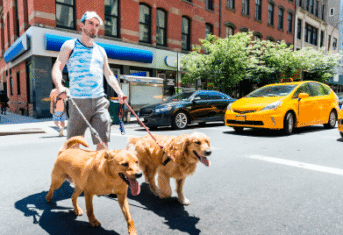Blindness in Pets

Blindness in Pets
Smiley, a blind Golden Retriever therapy dog and former puppy mill rescue, recently became an internet sensation. Born without eyes, Smiley bonded with a deaf Great Dane after he was rescued from the puppy mill. According to reports, the relationship drew Smiley out of his shell and turned him into a confident therapy dog, sharing his smile at schools, nursing homes and libraries.
Forms of Blindness
Smiley was born without eyes – medically known as ocular agenesis, but blindness in pets takes many forms. High blood pressure, especially in cats with kidney disease, causes blindness. The increased blood pressure causes vision loss from retinal detachment and intraocular hemorrhage. Chronic herpes infection in a cat’s eye can cause corneal ulcers that are painful, difficult to heal and which can lead to blindness. A lack of tear production or dry eye predisposes dogs to corneal ulcers and scarring, and if left untreated, blindness. Both dogs and cats develop glaucoma, a painful swelling of the eye. If the swelling cannot be controlled, glaucoma can rob pets of their vision.
AMC TO THE RESCUE Helps
Doc, a mixed breed puppy, had developed glaucoma, a painful increase of fluid inside the eyeball that damages or destroys vision. Doc came to see The AMC’s board certified ophthalmologist, Dr. Alexandra van der Woerdt, through a joint effort between AMC TO THE RESCUE and Doc’s rescue group, Louie’s Legacy. AMC TO THE RESCUE funds specialty care to rescued pets whose medical conditions form a barrier to their adoption, preventing them from finding a forever home.
Dr. van der Woerdt determined Doc’s vision could not be saved, and because his eyes were painful, she outlined three options to make him pain free. First, surgical enucleation, or total removal of the eye; second, chemical ablation, where a substance is placed into the eye to destroy the fluid-producing tissue, lowering the pressure inside the eye; and finally, placement of an intraocular prosthesis. This device maintains blinking eyeball shape, but removes the “insides” of the eye so fluid is no longer produced and the eye is no longer painful. Doc underwent surgical enucleation of both eyes.
New Family and a New Name
Doc is now Zach, the name bestowed by his new family who adopted him shortly after the enucleation surgery. A new name is fitting since Zach is a new dog because he no longer suffers from painful eyes. Zach’s new family says, “He is doing super well. He loves to wrestle at the dog park and can navigate around our house and neighborhood with ease. Most people don’t even notice that he is blind!”
AMC TO THE RESCUE is proud to have helped turn one more unadoptable rescue dog into a beloved family pet. For more information about this vital Community Fund, or to donate, please visit our website.

































